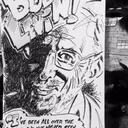Stay in the Loop
BSR publishes on a weekly schedule, with an email newsletter every Wednesday and Thursday morning. There’s no paywall, and subscribing is always free.
This month, Bob Dylan, one of the most significant American rock artists of our lifetime, will play Atlantic City and Philadelphia. It’s part of a 30-concerts-in-43-days cross-country tour, which shows good energy for anyone, let alone a 75-year-old grandfather of nine and heart disease survivor. Opening will be Mavis Staples, who, Dylan scholars will recall, rejected his marriage proposal in the early 1960s. For those who will attend either show but have not been following the old song-and-dance man, consider the following a public service announcement designed to steer your expectations onto safely appreciative ground.
The ballad of Bob
“Uncle Bob,” as he is known to younger devotees, makes no grab at the title “Mr. Excitement.” He will not play guitar. He will play harmonica a couple of times and piano a half dozen. He will sing nine songs, say something on the order of “Thank you (unintelligible)... We’ll be right back,” and exit. (He will say nothing else the entire evening.) After intermission, he will sing nine more songs and a two-song encore, regardless of how much you applaud.
Dylan will not strut, dance, duck walk, or mince. His go-to move is taking four small steps back from the microphone, pausing momentarily, feet planted like a gunfighter, and then taking four steps forward to resume. He will direct his band with stiff-armed signals. He will wear a white flat-brimmed hat, and cavalry-striped black pants.
Dylan will perform three songs he wrote before 1975, and 10 he wrote after 2000. He will perform seven written between 1923 and 1954 by others, all of which Frank Sinatra has recorded. You will wish Dylan had done more originals. You will wish he chose different originals. He has sung the same songs in the same order at every stop of this tour, save for recently replacing two Sinatras with two other Sinatras. (Complete set lists are available here.)
Versatile band, lively performance
But put your preferences aside and you will have a great evening.
For one thing, Dylan’s band – Tony Garnier (bass), Donnie Herron (banjo, viola, violin, mandolin, pedal and lap steel), Stu Kimball (rhythm guitar), George Receli (drums) and Charlie Sexton (lead guitar) – is terrific. Each is a fine musician, and touring as a unit with Bob for three years has fused their individual talents into a compact, efficient engine, powering each song toward its intended emotional effect. Their soloing, while restricted, adds inventive decoratives without distracting from their goal. They are at ease with swing, rhythm and blues, ballad, or rockabilly. They can make your feet tap and your heart bleed. Dylan seems eminently comfortable in their surround as he travels this leg of his journey.
And his singing is superb. He seems committed to his performance and to the lyrics of each number – no dialing it in this time around. He pines, croons, snarls, growls. He is exploring, as he has always explored, his relations with both inner and outer worlds, but there seems a new degree of fulfillment within him.
But what does he really mean?
Perhaps the best thing about any Dylan show is the questions it raises. A serious artist, he has always worked beyond mere entertainment. Still, even as three generations turn out to absorb, enjoy, and understand him, he endures, enigmatic as ever. What the hell is he up to? You ask and develop your own answers as a reward.
First, what is it with these standards? He can’t be honoring The Great American Songbook; his selections are too fair to middling. There is one Irving Berlin but no Gershwin, Hart, Hammerstein, or Porter. (None are even Sinatra signature numbers; a few are positively obscure.) Some suggest Dylan grew up enjoying these songs, but I am his age, and I doubt that. One commentator posited that by juxtaposing these tunes beside his own, Dylan demonstrates how they pale beside his genius; I doubt this too. His interpretations are too respectful. I think he came across them as he came across songs from American blues, gospel, country and western, and bluegrass traditions and culled from them that which spoke to his own feelings and beliefs.
Then there is the significance of his evening’s ordering. He opens with “Things Have Changed,” with its bitter “I used to care, but...” refrain, voiced by a doomed man on a hopeless path. That establishes a point of view sustained through songs about “nothing at all,” “blood,” and “wasted years.” But Dylan encores as if time has flowed backwards to his own youth, restoring that old, reliable, inspirational, blowin’ wind. As you wait for that sentiment to root and flowers of cheer to bloom, he discharges you into the streets with “Love Sick.” He hears no answers in the wind or anywhere, only lies and cries and a ticking clock.
Yet, “I’m tryin’ to forget you... (but) I’d give anything to be with you” is that stricken song’s conclusion. Is Dylan saying that, despite love’s pain and disappointment, he wishes to revive the time when love and caring mattered? That he is still on the road, delivering his magic, warring, one suspects, against demons, seeking his answers, seeking to move audiences to theirs suggests it is at least an open question.
What, When, Where
Bob Dylan. July 10, 2016 at the Borgata Hotel Casino and Spa, One Borgata Way, Atlantic City, NJ. (609) 317-1000 or theborgata.com. July 13, 2016 at the Mann Center, 5201 Parkside Ave., Philadelphia. (215) 546-7900 or box-officetickets.com.
Sign up for our newsletter
All of the week's new articles, all in one place. Sign up for the free weekly BSR newsletters, and don't miss a conversation.

 Bob Levin
Bob Levin
